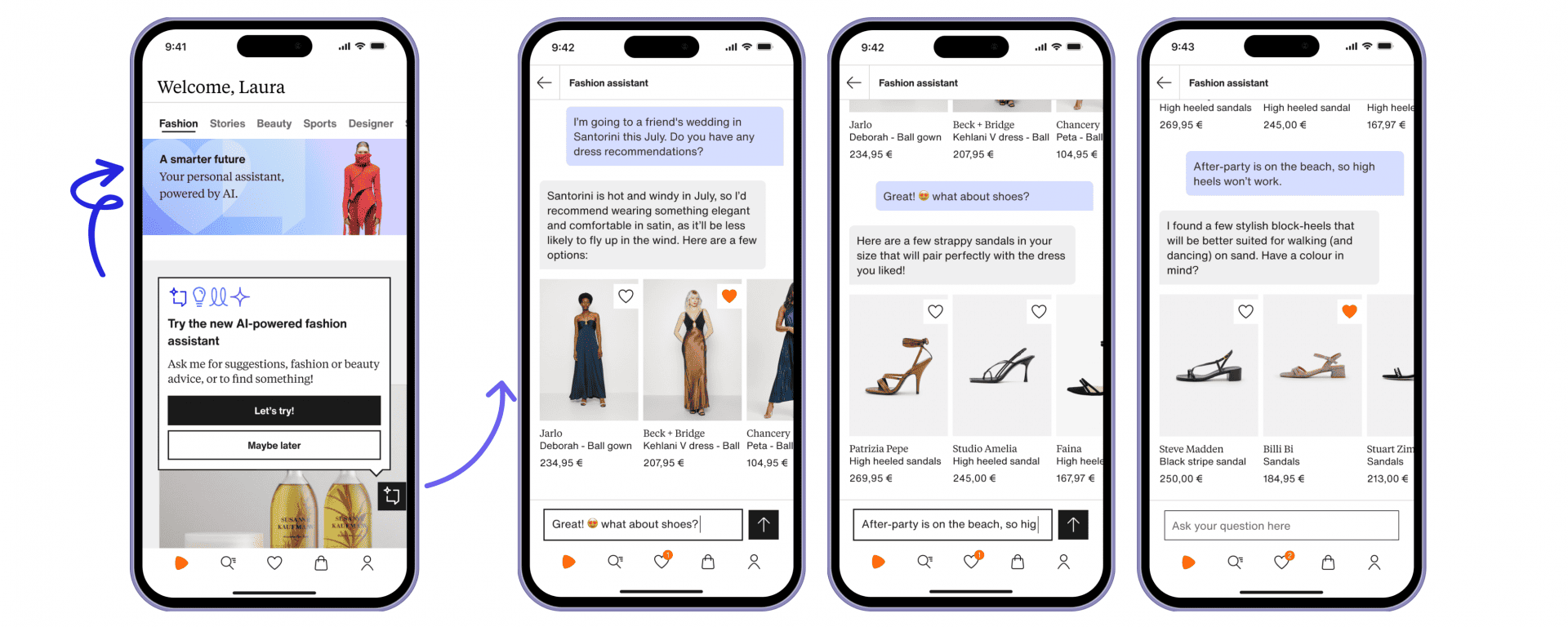- Introduction
- How is AI transforming the e-commerce industry?
- AI tools for e-commerce businesses
- Recommendation engines
- Dynamic pricing tools
- Chatbots for customer service
- Customer segmentation tools
- Smart logistics systems
- Sales and demand forecasting
- Voice search
- Visual search
- Fake reviews identification
- Fraud detection and prevention
- Auto-generated content
- What benefits do AI tools bring to e-commerce businesses
- How leading businesses harness AI tools for success
- 1. Recommendations tailored to your customers
- 2. Flexible pricing based on market conditions
- 3. Chatbots for enhancing customer service
- 4. Better marketing promotions and customer segmentation
- 5. Efficient production with smart logistics systems
- 6. Sales and demand predictions for improved planning
- 7. Enhanced experience with voice search
- 8. Visual search to ensure relevant products
- 9. Reduced fake reviews that can harm your business
- 10. Increased security with fraud detection
- 11. Always accurate product descriptions
- 💡 How does Walmart do it?
- 12. And what about Chat-GPT?
- Conclusion
- Frequently asked questions
Introduction
E‑commerce has been advancing slowly in the past few years, and the pandemic has only accelerated this process. With more people shopping online than ever, e‑commerce owners now have an opportunity to attract far more potential customers and face many challenges.
From growing customer demands and increasing numbers of support questions to attempts at fraud, anyone who owns an online shop has a lot on their plate.
To handle all those tasks without cutting corners, many online retailers have used artificial intelligence devices to help them learn more about their clients and provide outstanding customer service.
Could you also use AI in your shop? Here are a few ways artificial intelligence could also improve customer experience in your store.
How is AI transforming the e-commerce industry?
By the beginning of 2021, e‑commerce sales hit almost $5 bn; by 2024, experts say that will have jumped to over $6 bn per year.
We shouldn’t be too surprised – customers have been demanding a flexible but straightforward and convenient way to shop for years. And online shops are convenient:
- They are available 24/7
- Shoppers can research a product and price range from their homes.
- People can buy products in just a few clicks using online payments and have them delivered by courier or parcel locker.
Unsurprisingly, there are already over two bn online shoppers, and the number is quickly growing. But those customers have also gotten pretty savvy. Now that they have thousands of online shops to purchase products, they won’t settle for anything less than a perfect shopping experience.
This is where artificial intelligence-powered tools can be helpful for all sizes and types of e‑commerce companies. There’s far more to AI than just being a fancy toy for large companies. It can impact every part of your e‑commerce business, from inventory management to customer service.
According to Accenture, artificial intelligence can enhance business productivity by up to 40%. 87% of global business organizations believe that AI will give them a competitive advantage. What makes it so powerful, though? The ability to gather and analyze vast data to find patterns and then take action accordingly.
87% of businesses believe AI will give them a competitive advantage. (statista.com)
AI tools for e-commerce businesses
The integration of AI in e-commerce has revolutionized the industry, offering powerful tools that enhance customer experiences, streamline operations, and combat various challenges. Let’s explore some essential AI tools:
Recommendation engines
Recommendation engines use collaborative filtering algorithms to analyze customer behavior, preferences, and purchase history. By identifying user patterns and similarities, these algorithms predict products a user might be interested in, providing personalized recommendations.
Dynamic pricing tools
These tools leverage optimization algorithms considering competitor prices, manufacturing costs, and demand. By analyzing real-time data, these tools automatically adjust product prices to maximize profitability, ensuring optimal pricing at any moment.
Chatbots for customer service
Chatbots powered by NLP use machine learning to understand and respond to user inquiries in natural language. They handle routine tasks, answer customer queries, provide assistance during non-office hours, and can even collect feedback. While not entirely self-sufficient, they significantly reduce the workload on human support teams.
Customer segmentation tools
AI-driven customer segmentation tools utilize machine learning to analyze customer data and identify similarities. By examining various data points, these tools create accurate customer segments, enabling businesses to tailor marketing communications and strategies to specific audience segments.
Smart logistics systems
Smart logistics systems leverage IoT devices such as sensors, RFID tags, and smart shelves to gather real-time inventory levels and conditions information. This data is used to manage inventory efficiently, predict demand, and optimize supply chain operations, preventing overspending and improving production efficiency.
Sales and demand forecasting
AI-powered forecasting tools utilize machine learning algorithms to analyze real-time sales data, demographics, and various external factors (e.g., weather, online reviews). This enables businesses to make accurate predictions, improving inventory management, logistics planning, and pricing strategies.
Voice search
E-commerce companies optimize for voice search by incorporating natural language processing techniques. This ensures that websites and product listings are accessible through voice commands, providing a seamless and efficient shopping experience for users who prefer voice interactions.
Visual search
Visual search technology utilizes image recognition and AI algorithms to enable users to search for products based on images rather than text. This is particularly useful for users who may not know specific search terms, allowing them to find relevant products quickly and easily.
Fake reviews identification
Systems for identifying fake reviews use AI-driven text analysis to scrutinize text patterns, writing styles, and formatting. By comparing reviews and analyzing anomalies, these systems swiftly flag and identify suspicious reviews, helping businesses maintain the integrity of customer feedback.
Fraud detection and prevention
Fraud detection tools use AI algorithms to analyze user behavior, transaction patterns, and multiple parameters associated with user identification and credit card information. By understanding the context and detecting irregularities, these tools identify and prevent potential fraudulent activities, ensuring secure financial transactions.
Auto-generated content
AI-powered tools for auto-generating product descriptions use natural language generation techniques. These tools analyze product specifications and utilize copywriting principles like AIDA (attention, interest, desire, action) to create engaging, unique, and optimized content.
What benefits do AI tools bring to e-commerce businesses
Artificial intelligence brings numerous benefits to e-commerce businesses, positively impacting various aspects of business operations and customer experiences:
Enhanced customer experience
AI algorithms analyze users' previous behavior on the platform, history, browsing, etc., and based on the data, provide personalized recommendations. This saves them the time they would spend searching, enhancing their satisfaction and experience and driving higher conversion rates and customer loyalty.
Real-time decision-making
AI-driven sales forecasting and demand prediction tools utilize real-time data, demographics, and various factors (e.g., weather and online reviews) to make accurate predictions. This empowers businesses to make informed decisions quickly and adapt to changing market conditions.
Improved marketing effectiveness
AI analyzes customer data to create accurate segments and personalize marketing campaigns. This targeted approach increases the relevance of promotional efforts, leading to higher conversion rates, improved ROI, and enhanced campaign productivity.
Increased security
AI-powered fraud detection tools analyze user behavior, transaction patterns, and multiple parameters to identify and prevent fraudulent activities. This enhances financial transaction security, protecting businesses and customers from potential threats.
Operational efficiency
AI-powered tools, such as dynamic pricing optimization and smart logistics systems, automate repetitive tasks and decision-making processes. This streamlines operations reduces manual efforts and ensures optimal resource utilization.
Cost-efficiency
AI tools optimize pricing strategies, detect fraud, and automate routine tasks. This results in business cost savings by improving efficiency, reducing errors, and preventing financial losses associated with fraudulent activities.
How leading businesses harness AI tools for success
Thanks to machine learning algorithms, AI devices also get “smarter” the more they interact with customers and the more data they have to process. Using big data from your customers’ previous purchases and interactions, you can pinpoint what they want and deliver messages that resonate with them.
Here are a few examples of businesses that use the power of AI to the fullest. Read on to learn how to use data gathered by AI to boost your e‑commerce store’s customer experience.
1. Recommendations tailored to your customers
With personalized product recommendations, shop owners can personalize customer interactions and provide more relevant online shopping experiences that drive higher conversion rates, average order values, and customer loyalty. And AI‑powered recommendations can help tremendously here.
💡 How does Netflix do it?
For example, Netflix’s recommendations engine (NRE), powered by AI, is worth $1 bn per year. How does it handle providing detailed and tailored recommendations to millions of subscribers?
NRE uses algorithms to filter content based on each user’s profile. It can filter over 3,000 titles at a time using 1,300 recommendation clusters to pinpoint the exact titles a user might be interested in.
By analyzing data from each customer visit and click, the recommendation engine can “understand” that person’s preferences and create hyper-personalized recommendations for each. And it doesn’t matter how many customers you have – the engine can instantly match a given customer to the right products or offers.

2. Flexible pricing based on market conditions
The right price for your product depends on several factors, such as your competitors’ prices, manufacturing costs, and client demand. Researching this all takes time, especially if you have many products. That’s where AI comes in handy.
With AI, you can price your products at the optimal price at any given moment, taking into account your costs and competitors’ prices through big data. Additionally, such systems can predict when to raise the price of a product and when to launch a sale if it has access to the correct data.
AI can also change the prices for hundreds or thousands of products in your store, saving time on manual adjustments. How could you use it in practice?
For example, increasing your prices when your competitors’ stocks are low. When consumers want a product right away, but it’s unavailable on one website, they will more than likely be willing to pay a higher price if they know they can get it from your store sooner.
💡 How does Amazon do it?
Amazon is one store that fully utilizes a dynamic pricing strategy. Whenever its competitors offer promotions or discounts, they regularly adjust their product prices by up to 20%.
However, it does so gradually to ensure maximum profitability based on sales forecasts. This allows it to remain the cheapest and maintain control over its profit margins.
3. Chatbots for enhancing customer service
Keeping up with customer requests can place significant pressure on support teams. Customer support teams have their hands total daily, whether answering pre-purchase questions, helping with checkout issues, or dealing with returns and exchanges. What’s more, customer expectations are now much higher than ever.
An “immediate” response within 10 minutes is rated as necessary or very important by 90% of customers. So, using virtual assistants or chatbots on your website is a great way to boost your customer support while freeing up your support team of too many tasks.
You can offer customer support even during weekends and holidays with AI‑powered chatbots. While your human support team is away, a chatbot can answer simple questions or tasks, route customers to suitable knowledge base materials, or allow them to leave messages for agents and schedule callbacks.
While these bots are not entirely self-sufficient, they can answer around 80% of daily questions, allowing live support agents to focus on more complex issues. You can also use chatbots to collect customer feedback automatically by, for example, asking them to fill out short surveys and then automatically collecting the answers.
💡 How does Zalando do it?
Zalando employs chatbots to enhance user experience and drive sales. The chatbot implemented by Zalando serves as a virtual assistant, assisting users in various aspects of their online shopping journey.
The chatbot not only assists users in finding fashion items but also provides fashion advice, recommends products and even whole outfits, and helps with ordering.
Integration of chatbots that serve as valuable tools enhances customer experience, streamlines support processes, and ultimately drives sales by providing personalized assistance and guidance throughout the user’s journey.

4. Better marketing promotions and customer segmentation
In this survey, 80% of audiences said they prefer doing business with a brand that personalizes their user experience. Here, segmenting your audience is key to delivering tailored marketing communications.
Moreover, segmentation tactics can increase your marketing campaigns’ productivity, effectiveness, and ROI. For example, look at Campaign Monitor – their report found a 760% increase in revenue from segmented campaigns.
Those revenue numbers come from personalized marketing promotions, devising sales strategies to increase conversions from each segment, developing products that address the specific needs of particular segments, etc. But if you had to manually create groups for your customers, that would take far too long.
Here’s also where AI can lend a hand. By analyzing the data it has, artificial intelligence tools can swiftly create customer segments for you based on the similarities it find.
Moreover, they can analyze the data without any prior assumptions or biases, such as that young males should be the primary target for video games. At the same time, women are more interested in fitness products. Thus, AI can give you a far more accurate picture of your audience.
Many of those tools can also create entirely new segments for you by highlighting parts of your audience that could be overlooked by you or your team, even if they worked on the same data.
💡 How does Spotify do it?
Spotify leverages AI to create an individualized understanding of each user’s musical preferences, constantly adapting and refining its recommendations without relying on preconceived notions or biases.
The AI algorithms consider many factors, such as the user’s listening history, favorite genres, artists, and even the time of day when music is played. This approach enhances customer satisfaction and demonstrates how AI can provide a more accurate and dynamic picture of audience segments.
5. Efficient production with smart logistics systems
Like many industries, logistics can significantly benefit from using AI‑powered or “smart” devices and automating repetitive tasks. Smart or intelligent logistics use real-time information gathered through sensors, RFID tags, or similar to manage inventory levels better and predict demand.
A good example is using smart warehouse shelves that sense weight and pressure and sharing this info with warehouse management systems. With radio-frequency identification (RFID) or barcodes, companies can keep their inventories up-to-date by tracking when items are received, stored, picked, and shipped.
Businesses can thus increase production efficiency while preventing overspending, as there will be no risk of ordering more items than necessary because of a mess in the inventory.
AI can also allow you to keep track of all your products throughout the entire supply chain, from the manufacturer to your store, not just those already in it. Using a tracking system with integrated RFID and GPS technology, you can locate your products or supplies and even monitor in what conditions they are stored or transported.
As such, AI devices can be helpful if you have a lot of suppliers and vendors to keep an eye on. Doing so can minimize the likelihood of late deliveries or accepting damaged products.
💡 How does Amazon do it?
Amazon has heavily invested in intelligent logistics to streamline its operations and ensure efficient order fulfillment. The company utilizes a combination of advanced technologies to manage a massive inventory, fulfill orders rapidly, and optimize warehouse operations. Integrating intelligent technologies like RFID, barcodes, and smart shelves contributes to a highly efficient and automated logistics ecosystem.
6. Sales and demand predictions for improved planning
E‑commerce companies regularly use forecasting to manage inventories, plan logistics, and warehouse space, and determine pricing strategies. Yet accurately predicting demand is only getting more challenging because historical sales data are no longer enough, even when combined with seasonal data.
Many brands have turned to AI for sales predictions to make demand forecasts more accurate and reliable. Rather than just using historical data, AI makes real-time sales and demand predictions, including demographics, weather, the performance of similar items, and online reviews or social media. Machine learning will also improve forecasts over time with more available data.
💡 How does Danone do it?
Danone is among the companies implementing a machine learning system to improve demand forecasts. In addition to creating more accurate estimates for their short-life products, their machine learning system also improved planning between departments such as sales, supply chain, finance, and marketing.
This system also improved efficiency and inventory balance, helping Danone achieve its targeted service levels at the channel and store levels.
7. Enhanced experience with voice search
Voice search is an increasingly popular way for consumers to interact with their devices, and this trend is impacting the way people shop online. According to a survey by Perficient, 55% of consumers use voice search to research products, while 44% have used it to add items to their shopping lists.
In addition, Gartner predicts that by 2023, voice commerce will reach $80 billion globally. To capitalize on this trend, e‑commerce companies must ensure that their websites and product listings are optimized for voice search, including using natural language, optimizing for long-tail keywords, and providing clear and concise answers to common questions.
Furthermore, as voice search technology evolves, there may be opportunities to integrate voice assistants into the shopping experience, such as providing personalized recommendations or allowing customers to place orders using their voice.
51% of consumers who use voice assistants for shopping do so because it’s faster than using a website or app. (Narvar)
💡 How does Sephora do it?
A good example is the voice search offered by Sephora. In 2017, it launched one of the first Google Assistant actions, allowing users to book beauty services, play quiz games, and listen to beauty podcasts.
Users of Google Assistant can now shop at Sephora, and those with Google Home can even use Sephora’s Skincare Advisor tool to find nearby stores, get skincare tips, and determine their skin type. Users can also ask Google Assistant to play a Sephora makeup tutorial through Google Home.
8. Visual search to ensure relevant products
Visual search is another innovative feature many e‑commerce platforms are gradually introducing to attract more customers. This involves using artificial intelligence to enable shoppers to search online based on images instead of text or keywords.
For people who don’t know precisely what they’re looking for or type the wrong search terms into the search bar, this is extremely useful in helping them find relevant products faster and easier.
💡 How does Pinterest do it?
Pinterest’s Lens feature is an excellent example of this. With it, users can search for items in a photo they’ve taken with their phone’s camera or upload existing pictures from their camera roll.
In 2020, the visual search engine registered 459 million monthly active users who would search for new brands or products via visual search rather than regular search.
9. Reduced fake reviews that can harm your business
In the online shopping world, customer reviews are crucial to building trust. Since users cannot physically see what products look like before they buy them, they build up opinions based on reviews and ratings left by current and past buyers or users.
93% of shoppers read online reviews before purchasing, and 91% of 18-34s trust online reviews as much as personal recommendations. Sadly, many of those reviews aren’t exactly reliable.
Approximately 31% of online reviews are fraudulent, according to a report by Fakespot, a developer of AI technology that can recognize fake reviews. For this research, Fakespot analyzed studies from more than 2m active online stores on Shopify and leading e‑commerce platforms such as Amazon, Walmart, BestBuy, eBay, and Sephora.
However, self-learning artificial intelligence is becoming very good at identifying fake reviews. These systems can analyze text patterns, writing styles, and formatting to mark those that seem suspicious immediately.
They can also compare reviews in the blink of an eye and flag fake ones. This could be just what the e‑commerce industry needs to start winning the never-ending battle against fake reviews.
💡 How does Amazon do it?
Amazon leverages the power of advanced technology and proprietary data to identify and stop hundreds of millions of fake online reviews, manipulated ratings, fake customer accounts, and other abuses before customers see them. Machine learning analyzes data, e.g., whether the seller has invested in ads (which may be driving additional reviews), customer-submitted reports of abuse, risky behavioral patterns, review history, and more.
Furthermore, advanced language models are employed to scrutinize data irregularities in conjunction with natural language processing techniques. These anomalies could signify the potential falseness of a review or suggest that incentives like gift cards, complimentary products, or other forms of reimbursement have influenced it.
10. Increased security with fraud detection
According to the UK’s Office for National Statistics (ONS), nearly 63k consumer frauds were reported in the first half of 2020, of which around 41k were related to online shopping and auction fraud. What’s even more worrying is that during the first half of 2019 and the first half of 2020, online shopping and auction fraud increased by 37%.
As customers slowly shift from in-store to online purchasing, e‑commerce businesses are particularly susceptible to these attacks due to the increasing volume of transactions, orders, and deliveries.
However, AI-based fraud detection and prevention tools can help merchants gain the upper hand. After analyzing all available data and understanding the context, AI tools don’t have much trouble spotting and blocking suspicious transactions.
For example, a user might place many orders quickly, enter an unrecognized address in the relevant field, or skip over basic information required for delivery. AI can detect all such cases and alert business owners to potential fraud attempts.
Using AI to combat fakes, these engines can also analyze multiple ID or credit card parameters. This technology can also prevent abuse of promo codes and loyalty programs by catching users of numerous accounts or proxy servers to make various purchases.
💡 How does PayPal do it?
PayPal employs AI-driven fraud detection and prevention tools to secure financial transactions. AI algorithms analyze user behavior and transaction patterns, multiple parameters associated with user identification and credit card information, and address verification.
They also analyze patterns, leading to the identification of users with multiple accounts or individuals trying to leverage proxy servers for diverse purchases. ML ensures adaptation and continuously improves its fraud detection capabilities.
11. Always accurate product descriptions
Even for experienced copywriters, writing product descriptions that are both persuasive and SEO-friendly is not an easy task. The more products you have to sell, the longer it might take to write unique descriptions for each.
How about reaching out to AI‑powered tools for those? Of course, they are not on the level of professional copywriters, but when it comes to simple product descriptions, AI can quickly create engaging, unique, and optimized content based on the specifications.
Additionally, most AI tools can now use copywriting principles like AIDA (attention, interest, desire, action) to write like a human and cleverly add keywords to fit the text naturally. While AI-generated content, especially product descriptions, is not yet widely accepted by the industry, it’s probably a matter of time, considering how fast such tools armed with natural language processing are improving.
💡 How does Walmart do it?
Walmart employs AI-driven robots to scan shelves, generating product descriptions seamlessly for its online store. This streamlined process enables swift and precise updates to Walmart’s online inventory, ensuring informative and consistent descriptions. This initiative aims to enhance the overall customer experience and boost sales by providing up-to-date and comprehensive product information.
12. And what about Chat-GPT?
Chat GPT-powered conversational AI can help e‑commerce businesses provide personalized and natural customer interactions. With the ability to understand natural language and context, Chat GPT-powered chatbots can assist customers with complex queries, suggest products based on their preferences, and even provide customized recommendations.
This approach can help businesses build better customer relationships and bring personalized shopping experiences. By implementing Chat GPT-powered conversational AI, e‑commerce businesses can streamline their customer service operations and provide a more satisfying shopping experience.
Conclusion
With so much potential already visible, AI will become more important for e‑commerce owners. This technology can provide many benefits that others cannot offer – from saving you and your team time on various tasks to boosting your customer experience far beyond expectations.
Add to this helping you fight rising levels of fraud, improving your internal logistics, changing product prices on the go, and providing you with far more valuable data than ever.
In addition to these AI technologies, Chat GPT-powered conversational AI can revolutionize how businesses interact with customers.
Do you still doubt this will change the e‑commerce world and how customers find products online? Now may be a good time to start if you haven’t already used some of the before-mentioned solutions to power your business.
Frequently asked questions
What is the role of AI in e-commerce?
AI plays a crucial role in e‑commerce by enabling businesses to analyze and understand customer behavior patterns, enhance the shopping experience, and streamline various processes. AI can help in product recommendations, chatbots, personalized promotions, fraud detection, and more.
How can AI improve the e-commerce experience for customers?
AI can help personalize the customer experience by understanding their behavior patterns and preferences. It can also assist in providing product recommendations, predicting customer needs, and offering real-time customer service through chatbots.
What are the benefits of using AI in e-commerce?
The benefits of using AI in e‑commerce include increased efficiency and productivity, reduced costs, enhanced security, fraud prevention, personalized experiences, and better decision-making thanks to valuable insights from analytics.
What are some examples of AI in e-commerce?
Many examples of AI in e-commerce include personalized product recommendations, chatbots, virtual shopping assistants, dynamic pricing, fraud detection, and logistics optimization. AI can also help analyze customer reviews to improve product design and marketing strategies.
Barbora does magic with words in Luigi's Box as a product marketing specialist. She got into writing while studying at university as a volunteer for various civic associations. Besides being part of Luigi's Box marketing team, she co-organizes the TEDxBratislava conference, where she cares about marketing and PR.
More blog posts from this author







































